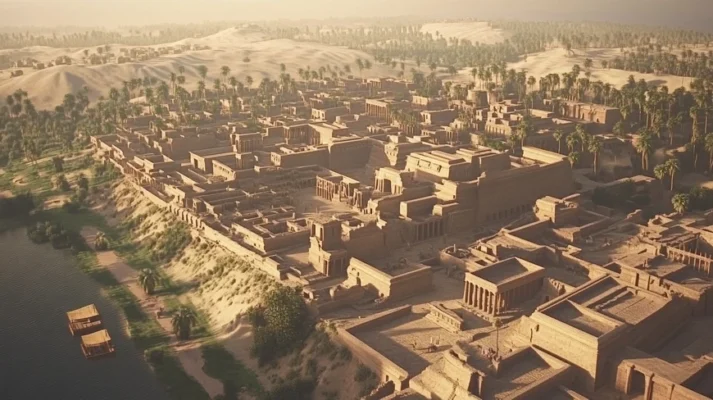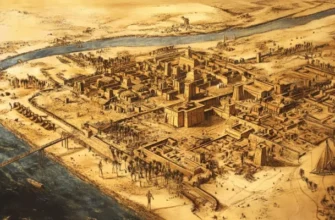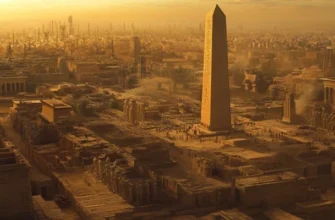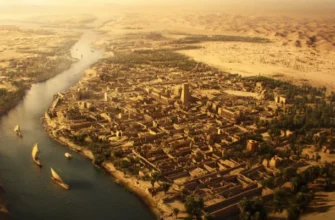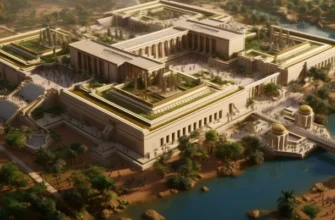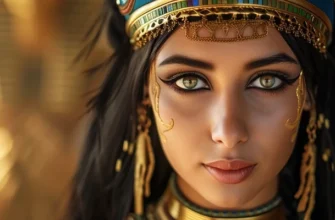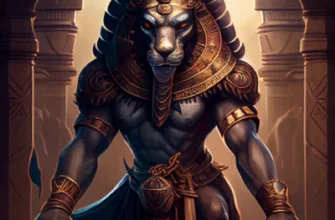Located to the west of the Nile Delta, Saïs was one of the most important cities in ancient Egypt, especially known during the reign of the 26th Dynasty (664-525 BC). This city became the capital of Egypt after it was chosen by Pharaoh Psammetichus I. Due to its strategic location, Saïs became an important economic and political center, as well as a cultural center.
One of the key features of Saïs was its religious significance. The city was dedicated to the goddess Nehbet, the protector of Upper Egypt, and there was a majestic temple that attracted pilgrims from all over the country. Religious rituals associated with this goddess played an important role in the spiritual life of the city.
Sais was also known for its architectural heritage. The remains of temples, palaces, and defensive walls found during archaeological excavations testify to the greatness and importance of this city. Today, archaeological research allows us to study life in Saïs, discovering numerous artifacts that help us better understand the history and culture of Ancient Egypt.
The legacy of Saïs, including its role in political life and religious practices, remains an important part of Egyptian history.
- History of Saisis
- Early periods and foundation of the city
- The heyday of the 26th Dynasty
- Religious significance of Sais
- The decline of Saïs
- Modern research and heritage of Sais
- Geography and location of Saïs
- The role of Sais in Egyptian political life
- The influence of Sais on the administrative structure of Egypt
- Religious significance of Saisu
- Religious holidays and rituals
- The Temple of the Swan and the worship of the goddess Nehbet
- The goddess Nehbet
- Temple of the Swan
- Archaeological excavations and findings in Saïs
- Exploring Saïs through archaeological research
- Tourism and popularization of Sais history
- Conclusion
History of Saisis
Saïs was one of the most important cities of Ancient Egypt, which gained particular fame and importance during the reign of the 26th Dynasty, from about the 7th century BC. The city was located in the Nile Delta, to the west of the main course of the river, and became an important political, economic and religious center of Egypt.
Early periods and foundation of the city
The earliest mentions of Sais date back to the Ancient Kingdom, but it was not of great importance until the New Kingdom. According to Egyptian sources, Sais was probably founded in the Middle Kingdom (approximately the 20th century BC), but it was during the 26th Dynasty that the city gained its greatest importance.
The heyday of the 26th Dynasty
Saïs became the capital of Egypt after Pharaoh Psammetich I united the country in 664 BC, which had been divided into several parts under different rulers. Thanks to the strategic location of Sais, Psammetichus I was able to provide the city with great influence and prosperity. Under his rule, Saïs became not only a political but also a military and cultural center.
The pharaohs of the 26th Dynasty, who came from Saïs, played a key role in restoring Egyptian power after a period of decay and foreign conquests. They restored the Egyptian economy, improved trade, and influenced the development of culture and art.
Religious significance of Sais
The religious significance of Saïs was also enormous. The city was the center of worship of the goddess Nehbet, who was the goddess of Upper Egypt and symbolized protection and maternalism. The Temple of Nehbet in Saïs was one of the main religious sites that attracted pilgrims from all over the country. This contributed to the cultural and spiritual development of the city, as well as strengthened its influence on various segments of the Egyptian population.
The decline of Saïs
After the fall of the 26th Dynasty in the mid-6th century BC, when Egypt was conquered by the Persians, Saïs lost its importance. The Persian conquest of Egypt in 525 BC marked the beginning of the city’s decline. Although Sais remained an important city for some time, it no longer had the same influence as in its heyday.
Modern research and heritage of Sais
Today, Saïs is an important archaeological site that allows researchers to study the history and culture of Ancient Egypt. Excavations in Saïs have uncovered numerous artifacts, including the remains of temples, palaces, and statues, which testify to the city’s greatness in ancient times. Thanks to this research, we are able to better understand the role of Saïs in Egyptian history and its importance as a religious and political center.
Geography and location of Saïs
Saïs was located in the western part of the Nile Delta, in Lower Egypt, about 60 km northwest of the modern city of Alexandria. This strategically important place was located on the border between Upper and Lower Egypt, which made it convenient for controlling all major trade and transportation routes in the region.
The city was located to the southwest of the main course of the Nile, which allowed it to have access to the fertile lands of the delta and convenient connections to other cities and territories of Egypt. Sais controlled important waterways, which provided it with great strategic and economic importance. Remnants of ancient canals and ruins preserved on its territory testify to the close connection with the Nile River, which was the main source of life and prosperity for the city.
Saisu’s location in the Nile delta favored the development of agriculture, particularly grain farming, which was the city’s main economic activity. The city also became an important trading center due to its strategic position between Egypt and foreign territories, which provided it with a significant economic flow.
The surrounding area of Sais was rich in natural resources, including fertile land for agriculture, which allowed for the cultivation of various crops. In addition, the Nile provided important resources such as water, fish, and other aquatic products. The city’s location in the heart of the delta made it an ideal place for the development of large religious and political structures, including temples and palaces, which became an important part of Saisu’s cultural heritage.
Thus, the geographical location of Saïs at the crossroads of important trade and cultural routes, its proximity to the Nile and fertile lands ensured that the city played a major role in the development of ancient Egyptian civilization.
The role of Sais in Egyptian political life
Saïs played an important role in the political life of Ancient Egypt, especially during the heyday of the 26th Dynasty (664-525 BC). The city became the center of political power when Pharaoh Psammetich I chose it as his capital after the unification of Egypt. Its strategic location in the Nile Delta and access to important trade routes allowed Sais to become a key political center in Egypt.
After Psammetichus I gained power and unified Egypt in 664 BC, he made Saïs the capital of Egypt. This decision significantly increased the political importance of the city, as Sais became not only the administrative but also the symbolic center of Egyptian statehood. The choice of Sais as the capital contributed to its prosperity and strengthened political stability in the country.
The 26th Dynasty, which originated from Saïs, became one of the most significant in Egyptian history. The pharaohs of this dynasty, such as Psammetich I, Necho II, and Psammetich II, placed great emphasis on strengthening the central government, rebuilding the Egyptian army, and developing the economy. Under their rule, Saïs became not only the capital, but also an important center of government, where key political decisions were made.
During the reign of the 26th Dynasty, Saïs was also an important political player in the international arena. The pharaohs of the dynasty actively pursued diplomatic relations with other countries such as Assyria, Mesopotamia, and Phoenicia. In particular, Necho II was known for his diplomatic policy and ambitions to expand Egypt’s influence in the region. He also made great expansion on the sea routes, organizing sea voyages and building ships for trade and military purposes.
The influence of Sais on the administrative structure of Egypt
Saïs became the center of Egyptian administration and centralized power. Important administrative decisions, including the allocation of resources, military campaigns, and religious rites, were made in this city. In addition, Sais became the site of numerous reforms in public administration, which contributed to the development of the Egyptian bureaucracy and strengthened the country’s infrastructure.
The decline of Saïs began after the Persian invasion in 525 BC during the reign of Cambyses II. Persia conquered Egypt, and Sais, although still an important city, no longer had the same political influence as before. As a result of the Persian occupation and the later Ptolemaic dynasty, Sais’s role in Egyptian political life diminished.
Consequently, Saïs was a key political center during the heyday of the 26th Dynasty, significantly influencing the development of the state and Egypt’s international policy.
Saïs was an important religious and cultural center of Ancient Egypt, especially during the reign of the 26th Dynasty. The city not only became the political capital, but also an important center of religious practices and cultural traditions. Its religious role, in particular, was closely connected with the cult of the goddess Nehbet, as well as with the rituals that took place in the majestic temples and sanctuaries.
Religious significance of Saisu
One of the main religious elements of Saisu was the cult of the goddess Nehbet. She was the goddess who protected Upper Egypt, and her image was often associated with guardianship, motherhood, and protection of royalty. The temple of Nehbet in Saïs was one of the main religious centers where important rituals and festivals took place. During this period, the city was a place of pilgrimage for thousands of believers who came to pay homage to the goddess and receive her blessings.
In addition to Nehbet, other Egyptian deities were worshipped in Saïs, although the main cult was that of the goddess Nehbet. This religion played an important role in the political life of the city, strengthening the connection between the pharaoh and the divine forces that supported his rule.
Saïs was known for its architectural heritage, especially the temples, palaces, and shrines that have survived to this day. One of the city’s greatest architectural achievements was the construction of the Nehbet Temple, which became a symbol of Egypt’s power and spiritual strength. Temples and shrines in Saïs not only served religious purposes but also acted as cultural centers where important cultural and social events took place.
In addition to religious buildings, palaces and administrative buildings were also built in Saïs, indicating the high level of development of Egyptian culture at that time. This city became a center for the dissemination of art, literature, and science. Due to its central role in the state, Saïs also influenced the development of Egyptian painting, sculpture, and architecture.
Religious holidays and rituals
Saïs was an important center of religious festivals that attracted believers from all over Egypt. One of the most famous festivals held in Saïs was the festival in honor of the goddess Nehbet. Important rituals included sacrifices, songs, and dances that accompanied the worship of the goddess. These celebrations contributed to the unity of the population, strengthened religious traditions, and increased the political legitimacy of the rulers.
During the 26th Dynasty, Saïs became an important cultural center where various cultural traditions intertwined, including Egyptian, Mesopotamian, Assyrian, and Phoenician. This contributed to the development of new art forms and ideologies. During the reign of the pharaohs of this dynasty, there was a period of cultural revival, which manifested itself in new architectural forms, improved religious rites, and flourishing literature.
Saisu religion and culture played a key role in the development of Egypt’s political and spiritual atmosphere during the 26th Dynasty. The cult of the goddess Nehbet, architectural achievements and cultural traditions of the city became important components of Egyptian civilization that continued to influence subsequent generations. Saïs left a significant mark on Egyptian history as the religious, cultural, and political center of the country.
The Temple of the Swan and the worship of the goddess Nehbet
The Temple of the Swan in Saïs was one of the most important religious centers of Ancient Egypt, where the goddess Nehbet was worshipped. This place became important not only because of its architectural grandeur, but also because of its role in religious practice, which combined cults, symbols, and rituals.
The goddess Nehbet
Nehbet was one of the main goddesses of Egypt, a symbol of protection, motherhood, and royalty. She was the goddess of Upper Egypt and was often depicted as a white swan or as a woman with a swan’s head. Her cult in Saïs was very important, and the temple dedicated to this goddess became a center of worship. According to Egyptian beliefs, Nehbet was the patroness of the royal family and the protector of the pharaohs. She was often associated with the crown of Upper Egypt, which was shaped like a swan or a bird.
Temple of the Swan
The Temple of the Swan in Saïs, as known from archaeological excavations, was a majestic religious complex dedicated to Nehbet. The temple had a swan as its symbol, as this bird was directly related to the image of the goddess, who was depicted as a white swan. The temple was not only a place of worship but also an important cultural and political center. Religious rituals, festivals, and ceremonies were held here in honor of Nehbet, as well as prayers and sacrifices.
Archaeological findings show that the temple was impressive in size and had a rich decor, including bas-reliefs, statues, and images of Nehbet in the form of a swan or a woman. One of the important features of the temple was the use of bird symbolism to express divine protection and guardianship, which was in line with a major aspect of her cult.
Religious rituals held at the Swan Temple included sacrifice ceremonies, prayers, and other rites dedicated to Nehbet. Because she was a symbol of protection and royalty, worshiping her became important to pharaohs and their families. In religious practice, symbols of the swan were often used for blessing and protection, as well as to maintain the unity and stability of royalty.
In addition, the temple was important for the development of Egyptian culture, as it not only served religious purposes but was also the center of cultural events such as literary works, art, and other manifestations of Egyptian creativity.
The Temple of the Swan and the worship of Nehbet were of great importance for the political and religious life of Egypt. They strengthened the connection between the gods and the pharaohs, reflected the greatness of the state, and enhanced the authority of the rulers. Thanks to the temple and its religious rituals, Saïs became an important center of Egyptian spirituality, attracting pilgrims from all over the country and supporting the political legitimacy of the pharaohs.
As a result, the Temple of the Swan in Saïs was an important religious and cultural center that played a key role in the worship of the goddess Nehbet and was an integral part of the spiritual and political life of Egypt at the time.
Archaeological excavations and findings in Saïs
Archaeological research in Saïs, an important city of Ancient Egypt, began in the 19th century and continues to this day. The excavations have revealed numerous relics that allow us to better understand not only the architecture and urban planning, but also the religious, cultural, and political aspects of the city’s life.
Saïs is located in the west of the Nile Delta, and its ruins have been studied by archaeologists since expeditions conducted by French and Egyptian archaeologists in the 19th century. The first important findings were made by scientists during the study of temples, palaces, and other architectural structures that testified to the greatness of the city during the reign of the 26th Dynasty.
The archaeologists paid special attention to the ruins of the temple dedicated to the goddess Nehbet, as well as the archaeological remains of city streets and administrative buildings. The findings from these excavations provided insight into the culture, art, and religious practices of Saisu.
One of the greatest archaeological interests is the remains of temples and shrines dedicated to various gods, including Nehbet. Archaeologists have discovered numerous statues, bas-reliefs, and religious images that testify to the popularity of this cult in Sais. Many of these artifacts are well preserved and can be seen in museums around the world, including the Egyptian Museum in Cairo.
In addition to religious objects, the finds also include details of the architectural design of temples, such as columns, obelisks, and tiles with inscriptions that tell the story of the history and rituals associated with the cults in Saïs.
The remains of palaces and administrative buildings allow us to better understand the organization of power in Saïs and its role as the political center of Egypt during the 26th Dynasty. In particular, the discovered ritual halls, throne rooms, and royal chambers demonstrate a high level of architectural skill and decoration. Rooms located next to temples often contained frescoes depicting scenes from the lives of pharaohs and gods.
One of the most important aspects of archaeological excavations in Saïs is the discovery of inscriptions and documents. Numerous cuneiform and hieroglyphic inscriptions left on the walls of temples and monuments provide historians with important information about the events of that time, the rulers and the political situation in the country. In particular, archaeologists have found many slabs with inscriptions covering religious rituals and events related to the pharaohs of the 26th Dynasty.
Finds related to religious practice also include small cult objects such as amulets, statuettes of gods, and other religious attributes used in daily rituals.
In addition to religious and architectural artifacts, archaeologists have also discovered numerous household items such as utensils, tools, clothing, and jewelry that provide valuable information about the daily life of the inhabitants of Sais. These findings confirm the high level of craftsmanship in crafts and production in this city.
In particular, processed stones, tools for agriculture, as well as coins and jewelry were found on the territory of Saisu, indicating the development of trade and crafts.
Archaeological excavations and finds in Saïs have become an important source for understanding the history, culture and religion of Ancient Egypt. The excavations of temples, palaces, and other architectural monuments, as well as numerous religious and domestic artifacts, allow us to better understand the significance of this city as an important political, religious, and cultural center in Egypt.
Exploring Saïs through archaeological research
Saïs, an ancient city in Egypt, was an important cultural, religious, and political center, especially during the XXVI Dynasty (Saïs Dynasty, ca. 664-525 BC). Its archaeological study reveals important information about the Late Egyptian period, interaction with other cultures, religious beliefs, and administrative practices.
Here are the main aspects that are being explored through the archaeological excavations of Saïs:
- Architectural monuments
Temple of Nate: Nate was the main god of Saisu. Archaeological research on the remains of the temple helps to understand the architecture, religious rituals, and significance of Neith in the later period.
Other sanctuaries and public buildings indicate the city’s political and religious role.
- Material culture
The finds of pottery, amphorae, jewelry, and tools reflect the daily life of the inhabitants of Saïs.
Unique artifacts testify to close contacts with the Greeks, Phoenicians, and other Mediterranean cultures.
- Inscriptions and hieroglyphs
Inscriptions on stelae, blocks, and artifacts provide important information about the political history, titles of the pharaohs, and their achievements.
- Necropolises
Burials in Saïs reveal information about the burial practices, social structure, and beliefs of the city’s inhabitants.
Excavations of tombs reveal both luxurious burials of the nobility and simple graves.
- Hydraulic structures and engineering
Saïs was located on the branches of the Nile, so archaeological research reveals irrigation systems, dams, and canals.
- Intercultural connections
The Greek and Phoenician artifacts found indicate that Saïs was an important trade and cultural hub.
- Destruction and current state
The city has suffered destruction, in particular due to the use of materials for construction in later periods. Archaeologists have to work with fragments and restore the context of objects.
Much of the territory of Sais remains unexplored due to modern development.
The study of Saïs contributes to the understanding of the political history of late Egypt, its international role in the Mediterranean region, and its cultural diversity. Saïs also shows how Egypt influenced neighboring civilizations while simultaneously adopting foreign ideas.
Tourism and popularization of Sais history
Sais has great potential for tourism development and popularization of its rich history. This ancient city, which was a political and religious center during the XXVI Dynasty, can attract tourists interested in little-known pages of Egyptian culture. Its archaeological sites, such as the ruins of the Temple of Nate, necropolises, and the remains of hydraulic structures, offer ample opportunities for archaeological tourism. The creation of a museum in Saisi to house artifacts found at the site could further increase interest in the city.
Saisi’s location in the Nile Delta allows for a combination of historical tourism and ecotourism. Tourists could explore the ancient irrigation systems and enjoy the natural landscapes of the region. At the same time, it is important to develop digital resources to popularize Saïs, such as virtual tours, educational videos, or 3D reconstructions of temples and other sites. International exhibitions and conferences dedicated to archaeological research at Sais will help spread knowledge about this unique site among scholars and the general public.
Infrastructure development plays a key role in attracting tourists. Improving roads, creating hotels and restaurants, and organizing excursion routes will help make Sais more accessible to visitors. It is also important to involve local communities in tourism projects by creating jobs, organizing tours with local guides, and selling handmade souvenirs inspired by the history of Sais. Holding cultural festivals dedicated to ancient Egypt will contribute to the economic development of the region and increase its popularity.
To preserve Sais monuments, investments in restoration work and international cooperation are needed. The involvement of organizations such as UNESCO will help protect archaeological sites and include Saïs in the World Heritage List. Popularizing the city’s history through literature, art, documentaries, or even movies could renew interest in this unique site. The balance between tourism and cultural heritage preservation is a key challenge, but Saïs has every chance of becoming an important cultural and tourist center in Egypt.
Conclusion
Saïs plays a key role in Egyptian history, being one of the most important centers in the late period, particularly during the reign of the XXVI Dynasty. This city was a political, religious, and cultural center that symbolized the revival of Egyptian statehood after a period of foreign domination. Saïs became the residence of the pharaohs, who sought to restore the traditions of ancient Egypt, including culture, religion, and architecture.
The main importance of Saïs lies in the fact that it was the center of worship of the goddess Nate, who personified wisdom and war. Her cult flourished in Saïs, which strengthened the city’s role as a religious center. In addition, Saisis was an important economic and trade hub that facilitated cultural contacts with the Mediterranean, particularly with the Greeks. The influence of these contacts is reflected in the material culture of the city, as well as in the spread of Egyptian traditions outside the country.
Saïs is also an important source for understanding the political history of late Egypt, as its pharaohs became symbols of national revival and resistance to foreign invaders. The city is noted for its unique role in preserving and transmitting ancient Egyptian traditions during a period of growing external influences.
Today, Saïs remains an important site of archaeological research, which is revealing new facets of its past. Its heritage is not only part of Egyptian history, but also a contribution to world culture, demonstrating how an ancient civilization could thrive, adapt, and interact with other cultures. The study of Saïs helps to better understand the later period of Egyptian history, as well as the relationship between tradition and innovation within one of the world’s oldest civilizations.
